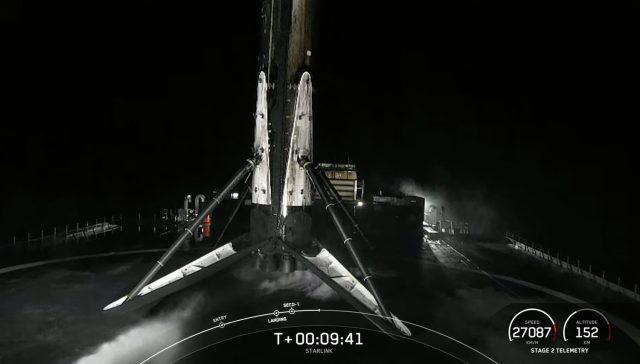A Falcon 9 rocket carrying another batch of Starlink Internet satellites lifted off at midnight on Sunday, setting a new record for the most flights by a SpaceX launch vehicle, the first-stage booster’s 16th flight. SpaceX now aims to fly its reusable Falcon 9 boosters 20 times, double the company’s original goal.
Months of inspections and upgrades to SpaceX’s high-flying rocket followed a “re-certification” of the booster to prove that the flight, at least on paper, could fly five more times after completing its 15th launch. and landed last December.
Sunday night’s mission got the Booster’s extended life off to a good start.
The record-breaking rocket lifted off from Cape Canaveral, Florida at 11:58 pm EDT (03:58 UTC) carrying 22 second-generation Starlink satellites. The rocket’s nine kerosene-fueled Merlin engines fired for about two and a half minutes to climb to the edge of space, then the booster separated toward landing on one of SpaceX’s floating landing pads northeast of the Bahamas.
The upper-stage engine ignited to launch the Starlink satellites into orbit. SpaceX declared the launch successful about an hour after Starlink loaded the payloads. The company’s global Internet network now has about 4,400 satellites in orbit, according to Jonathan McDowell, an astrophysicist who monitors spaceflight activity.
SpaceX plans to put thousands more Starlink satellites into orbit to increase the capacity of the network, which now has more than 1.5 million subscribers.
The Falcon 9 rocket’s first stage, standing about 15 stories high, settled on the drone ship’s deck less than nine minutes after launch, using thrust from its central engine to slow down for touchdown. It was the 46th launch of SpaceX’s Falcon rocket family this year, an average of one flight every four days.

“The Falcon 9 first stage has now successfully launched for a record 16th time,” said Kate Tice, SpaceX engineer hosting the company’s launch webcast. “Today’s landing marks the 206th overall landing of an orbital-class rocket, including the Falcon 9 and Falcon Heavy missions.”
This is SpaceX’s 216th successful mission for the Falcon rocket family, a feat unmatched in the history of space launch vehicles.
The booster, numbered B1058 in SpaceX’s inventory, flew Sunday night as the company launched its first astronauts in May 2020, sending NASA crew members Doug Hurley and Bob Behnken into space on the Crew Dragon Demo-2 mission. The mission ended a nearly nine-year gap in US launches carrying astronauts into orbit.
SpaceX’s fleet-leading booster has now launched 801 spacecraft and payloads and two more astronauts into service in more than three years.
This is the Falcon 9’s second booster lifetime
Engineers are working to certify up to 20 flights of Falcon 9 boosters for Starlink missions, Bill Gerstenmaier, SpaceX’s vice president of construction and flight reliability, said in May. Launches with customer satellites may be limited to rockets with low flight numbers. NASA has certified only Falcon 9 boosters with five or fewer flights for the agency’s space missions to the International Space Station.
“This gives us a lot of ability to reuse boosters and keep flying,” Kerstenmaier said. “I think we can meet our manifesto and then some with the boosters we’re working on.”
SpaceX’s latest iteration of the Falcon 9 rocket design, known as Block 5, flew for the first time in 2018. At the time, SpaceX was aiming to launch each Falcon 9 Block 5 booster 10 times. According to a report last year in the trade journal Aviation Week & Space Technology, SpaceX extended the life of 15 launches and landers by returning the boosters in good condition after each flight.
SpaceX put the booster components through vibration testing to four times the fatigue experienced over 15 flights, giving engineers confidence that the rockets would continue to fly successfully.
The company has about 16 flight-proven Falcon boosters in its fleet, and several new-build rockets are scheduled to fly by the end of the year. Each task requires a new upper level. Reusing the first stage and payload fairing not only lowers the company’s internal launch costs—believed to be less than $30 million per Falcon 9 flight—it opens up a higher flight rate without straining the factory.
SpaceX began the year with a goal of flying 100 missions by 2023, the most flights in a single year by any launch provider. SpaceX will fly 61 times in 2022. SpaceX continues to work on the Falcon 9 launch vehicle as it tests its largest Starship vehicle, with engineers designing it to be fully reusable with an even faster launch vehicle.
But the main limitation to SpaceX’s blistering launch rate isn’t the availability of flight-ready rockets — it’s the breakthrough of the company’s three Falcon 9 launch pads. SpaceX flew as often as every five days from Space Launch Complex 40 at the Cape Canaveral Space Force Station. The Falcon 9 launch pad at Vandenberg Space Force Base in California could be set up for another mission within 10 days.
SpaceX’s other fully operational launch pad at NASA’s Kennedy Space Center is currently the only pad to support crew and cargo flights to the space station and the only facility designed for the Falcon Heavy rocket. Those planes have priority at Kennedy’s Launch Complex 39A, and it takes up to three weeks to reconfigure the pad while transitioning between Falcon 9 and Falcon Heavy missions.